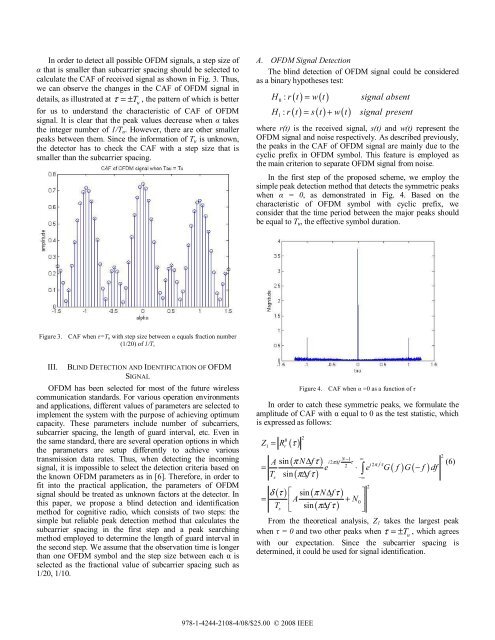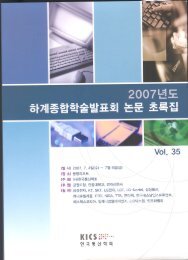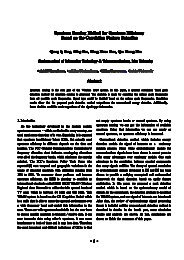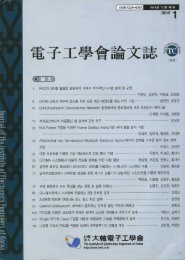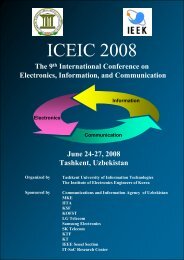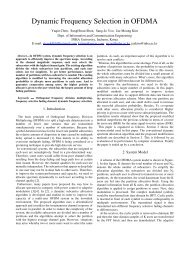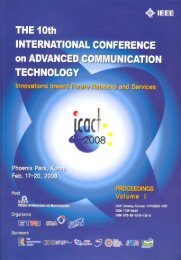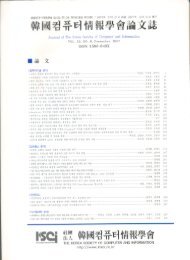Cyclic Autocorrelation based Blind OFDM Detection and ...
Cyclic Autocorrelation based Blind OFDM Detection and ...
Cyclic Autocorrelation based Blind OFDM Detection and ...
You also want an ePaper? Increase the reach of your titles
YUMPU automatically turns print PDFs into web optimized ePapers that Google loves.
In order to detect all possible <strong>OFDM</strong> signals, a step size of<br />
that is smaller than subcarrier spacing should be selected to<br />
calculate the CAF of received signal as shown in Fig. 3. Thus,<br />
we can observe the changes in the CAF of <strong>OFDM</strong> signal in<br />
details, as illustrated at u T τ =± , the pattern of which is better<br />
for us to underst<strong>and</strong> the characteristic of CAF of <strong>OFDM</strong><br />
signal. It is clear that the peak values decrease when takes<br />
the integer number of 1/Tu. However, there are other smaller<br />
peaks between them. Since the information of Tu is unknown,<br />
the detector has to check the CAF with a step size that is<br />
smaller than the subcarrier spacing.<br />
Figure 3. CAF when =Tu with step size between equals fraction number<br />
(1/20) of 1/Ts<br />
III. BLIND DETECTION AND IDENTIFICATION OF <strong>OFDM</strong><br />
SIGNAL<br />
<strong>OFDM</strong> has been selected for most of the future wireless<br />
communication st<strong>and</strong>ards. For various operation environments<br />
<strong>and</strong> applications, different values of parameters are selected to<br />
implement the system with the purpose of achieving optimum<br />
capacity. These parameters include number of subcarriers,<br />
subcarrier spacing, the length of guard interval, etc. Even in<br />
the same st<strong>and</strong>ard, there are several operation options in which<br />
the parameters are setup differently to achieve various<br />
transmission data rates. Thus, when detecting the incoming<br />
signal, it is impossible to select the detection criteria <strong>based</strong> on<br />
the known <strong>OFDM</strong> parameters as in [6]. Therefore, in order to<br />
fit into the practical application, the parameters of <strong>OFDM</strong><br />
signal should be treated as unknown factors at the detector. In<br />
this paper, we propose a blind detection <strong>and</strong> identification<br />
method for cognitive radio, which consists of two steps: the<br />
simple but reliable peak detection method that calculates the<br />
subcarrier spacing in the first step <strong>and</strong> a peak searching<br />
method employed to determine the length of guard interval in<br />
the second step. We assume that the observation time is longer<br />
than one <strong>OFDM</strong> symbol <strong>and</strong> the step size between each is<br />
selected as the fractional value of subcarrier spacing such as<br />
1/20, 1/10.<br />
A. <strong>OFDM</strong> Signal <strong>Detection</strong><br />
The blind detection of <strong>OFDM</strong> signal could be considered<br />
as a binary hypotheses test:<br />
1<br />
() = ()<br />
() = () + ()<br />
H 0 : r t w t signal absent<br />
H : r t s t w t signal present<br />
where r(t) is the received signal, s(t) <strong>and</strong> w(t) represent the<br />
<strong>OFDM</strong> signal <strong>and</strong> noise respectively. As described previously,<br />
the peaks in the CAF of <strong>OFDM</strong> signal are mainly due to the<br />
cyclic prefix in <strong>OFDM</strong> symbol. This feature is employed as<br />
the main criterion to separate <strong>OFDM</strong> signal from noise.<br />
In the first step of the proposed scheme, we employ the<br />
simple peak detection method that detects the symmetric peaks<br />
when = 0, as demonstrated in Fig. 4. Based on the<br />
characteristic of <strong>OFDM</strong> symbol with cyclic prefix, we<br />
consider that the time period between the major peaks should<br />
be equal to Tu, the effective symbol duration.<br />
Figure 4. CAF when =0 as a function of <br />
In order to catch these symmetric peaks, we formulate the<br />
amplitude of CAF with equal to 0 as the test statistic, which<br />
is expressed as follows:<br />
Z = R<br />
1<br />
0<br />
r<br />
( τ )<br />
2<br />
( πN∆fτ) ( π∆τ) A sin<br />
= ⋅ −<br />
T sin f<br />
s<br />
( ) sin ( N∆f )<br />
T sin ( π∆fτ) 978-1-4244-2108-4/08/$25.00 © 2008 IEEE<br />
N −1<br />
i2π∆f τ<br />
2 e<br />
∞<br />
i2π fτ<br />
e G( f ) G( −∞<br />
f ) df<br />
δ τ π τ <br />
= A + N0<br />
s <br />
From the theoretical analysis, Z1 takes the largest peak<br />
when = 0 <strong>and</strong> two other peaks when u T τ =± , which agrees<br />
with our expectation. Since the subcarrier spacing is<br />
determined, it could be used for signal identification.<br />
2<br />
2<br />
(6)


